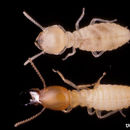The Formosan subterranean termite (
Coptotermes formosanus) is often nicknamed the super-termite because of its destructive habits and the enormous size of the colonies. A single colony may contain several million individuals (whereas other subterranean termite species typically number several hundred thousand individuals) in extensive underground foraging galleries and tunnels. The queen, which lives about 15 years, is responsible for producing all the eggs for the colony, up to 2000 eggs a day. Colonies pose serious threats to any nearby structures (boats, high-rise condominiums, even live trees and crops). While they rapidly eat wood and lumber which is composed mostly of cellulose, they also attack asphalt and plastic and even some soft metals to some degree. Once established, Formosan subterranean termites are extremely difficult, if not impossible, to eradicate from an area. Like other termite species,
C. formosanus are social insects and their colonies consist of three castes: workers (food gatherers), reproductives, and soldiers. When a colony grows large and splits, or if the colonies queen dies, up to 70,000 winged reproductives (alates) swarm from the nest and fly to mate and form a new colony. Alates are attracted to lights, and at night these insects can be seen as an impressive cloud, with the individuals being rapidly preyed on by lizards, birds, toads, ants and other predators.
Although
C. formosanus was first described in Formosa, Taiwan in the early 1900s, this species is probably endemic to southern China. The Formosan subterranean termite invaded the continental United States in the 1960s, having been transported to South Africa about a decade earlier.
Coptotermes formosanus is limited to warm and humid climates, and is restricted to ten of the most southern continental states in the US and to Hawaii, where it is a economically important insect pest. Control and repair of damage done by
C. formosanus in New Orleans, which has been heavily infested, is estimated at an annual total of $300 million. In Hawaii, homes built over an established colony can be destroyed in just two years unless the home is protected. Traditional control methods usually involve infusing chemical termicides into the ground to create a barrier between the colony and the endangered structure. Depending on the type, termicides either repel the termites or kill them on contact. Another approach is to use baited traps around the surface of a structure. Termites then take the bait, which is laced with a pesticide that the termite transports back to other members of the colony.
(
Su and Scheffrahn, 2010;
Wikipedia 2011;
Yates 1992)

